Abstract
This non-randomised concurrent cohort study conducted in two teaching hospital Departments of Surgery examined the assumption that the benefits of elective laparoscopic upper gastrointestinal surgery would apply to those with generalised peritonitis due to perforated peptic ulcers. It compared 20 consecutive laparoscopic repairs of perforated peptic ulcers with a concurrent group of 16 consecutive open repairs. There were no differences pre-operatively between the two groups. The mean duration of surgery was similar (P = 0.46). There were no differences in the rate of GI tract recovery, but opiate analgesia requirement in the laparoscopic group was significantly less (P < 0.0001). Intensive care was required in three patients in the laparoscopic group (two with renal failure) and two in the open (no renal failure). Two patients in the laparoscopic and one in the open group died. The median duration of stay was five days in the laparoscopic group and six in the open. This comparison shows that the patho-physiological insult of laparoscopy in the setting of generalised peritonitis does not obviously increase the peri-operative risk of organ failure but objective benefits are small.
Full text
PDF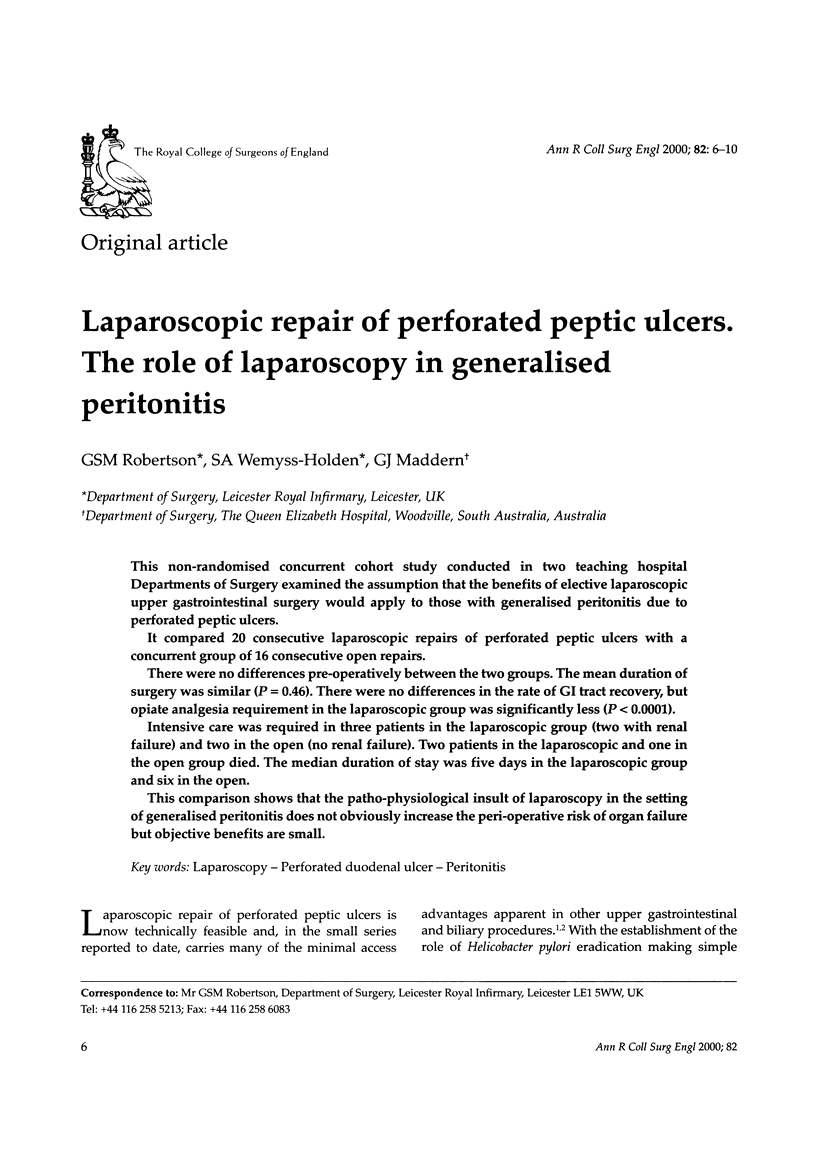
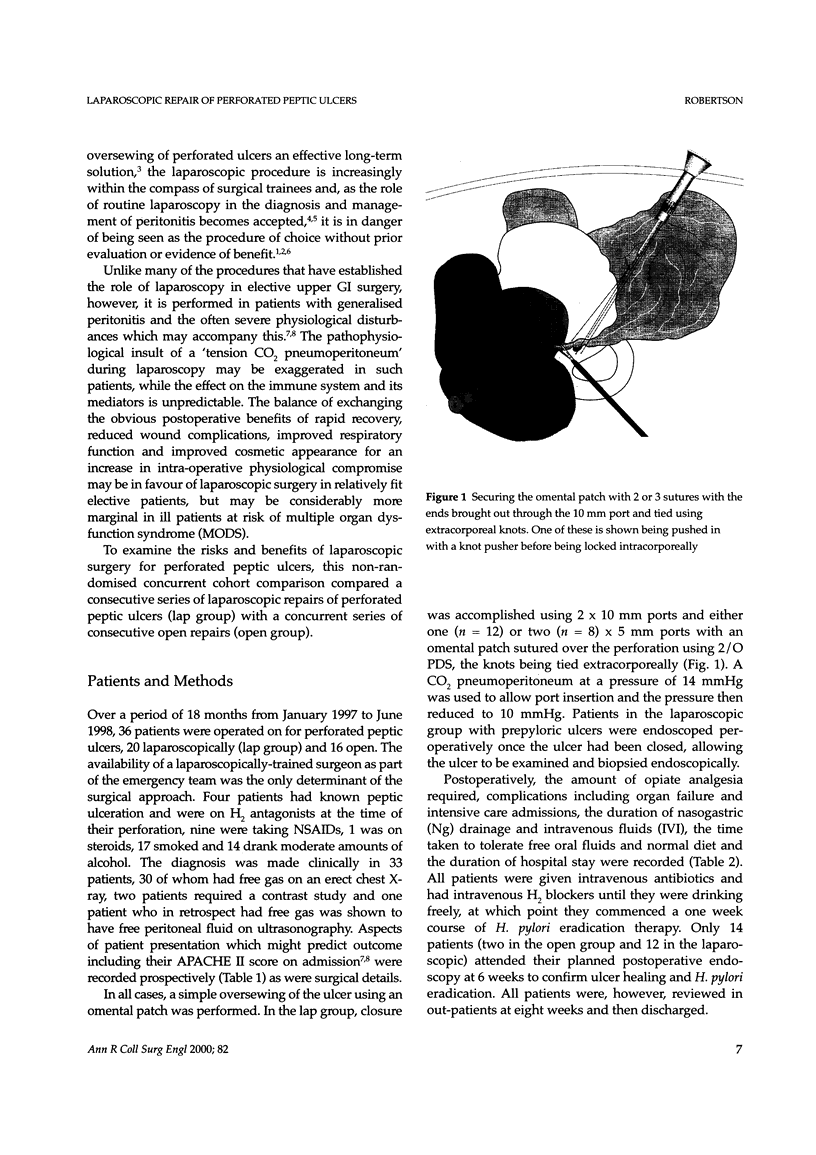
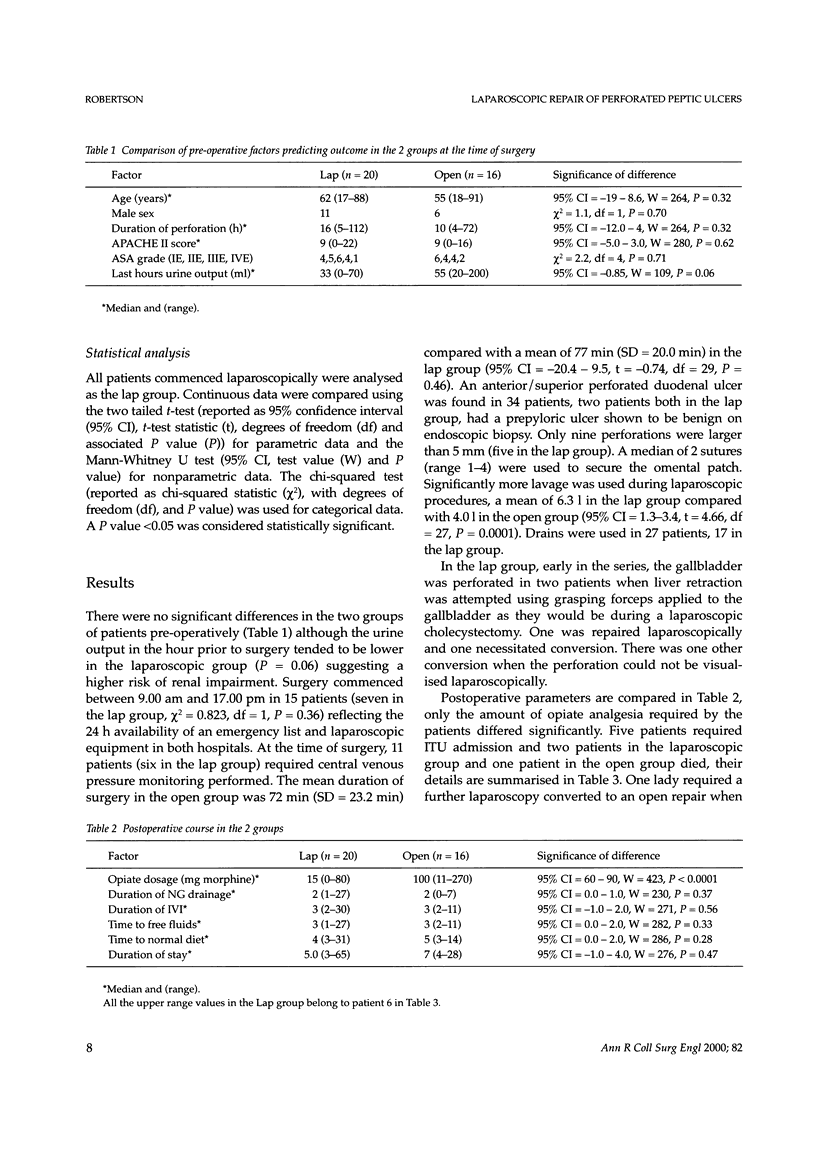
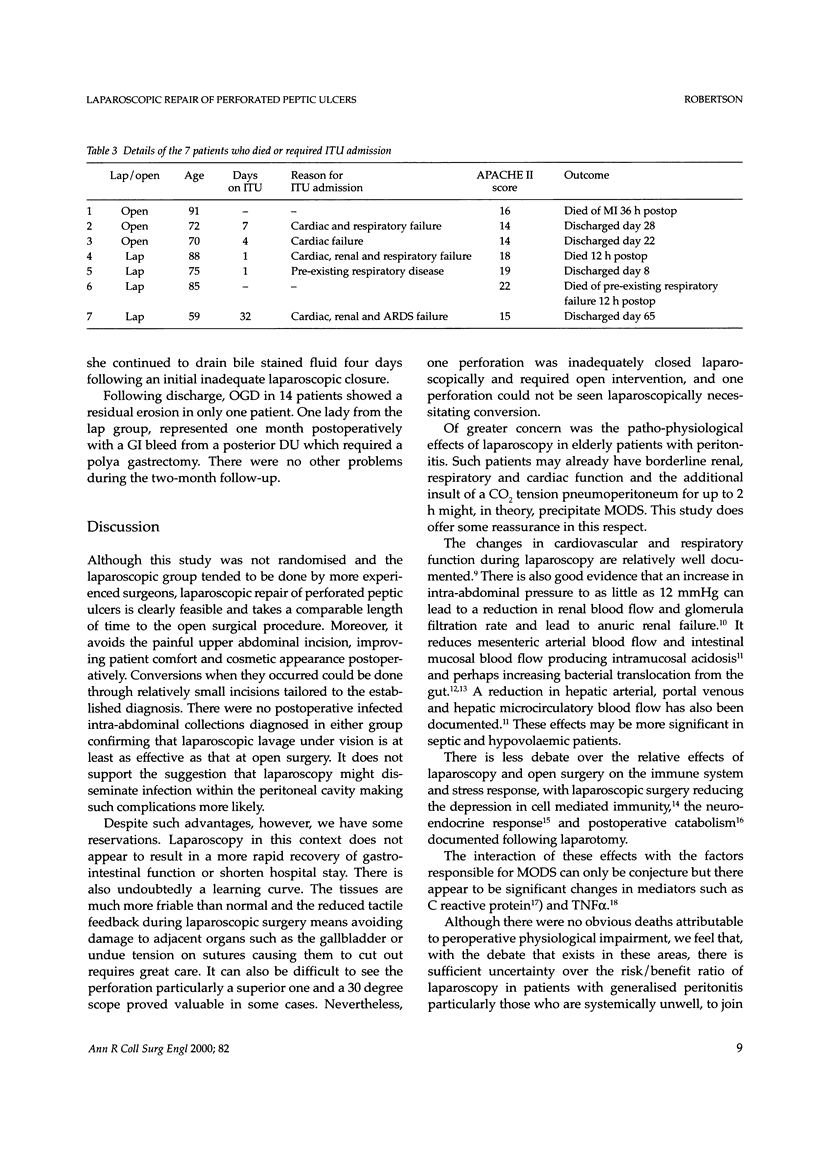
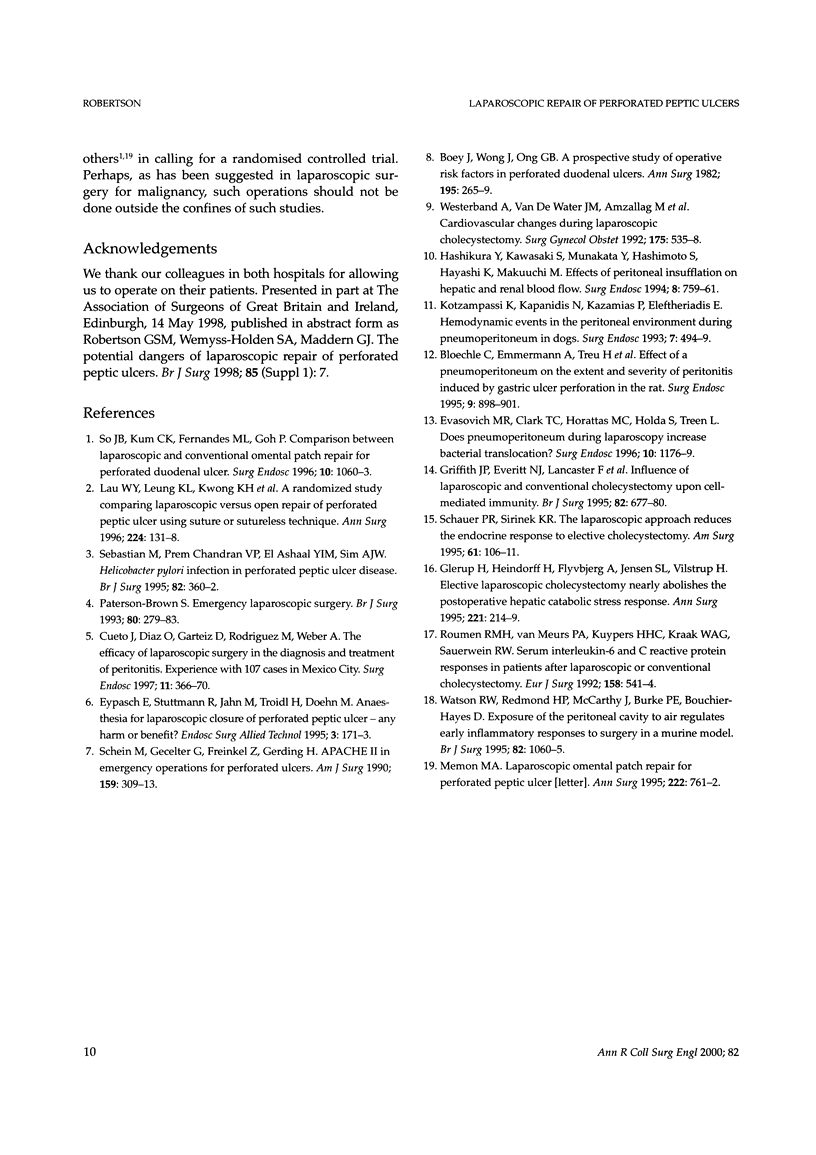
Selected References
These references are in PubMed. This may not be the complete list of references from this article.
- Bloechle C., Emmermann A., Treu H., Achilles E., Mack D., Zornig C., Broelsch C. E. Effect of a pneumoperitoneum on the extent and severity of peritonitis induced by gastric ulcer perforation in the rat. Surg Endosc. 1995 Aug;9(8):898–901. doi: 10.1007/BF00768887. [DOI] [PubMed] [Google Scholar]
- Boey J., Wong J., Ong G. B. A prospective study of operative risk factors in perforated duodenal ulcers. Ann Surg. 1982 Mar;195(3):265–269. doi: 10.1097/00000658-198203000-00004. [DOI] [PMC free article] [PubMed] [Google Scholar]
- Cueto J., Díaz O., Garteiz D., Rodríguez M., Weber A. The efficacy of laparoscopic surgery in the diagnosis and treatment of peritonitis. Experience with 107 cases in Mexico City. Surg Endosc. 1997 Apr;11(4):366–370. doi: 10.1007/s004649900365. [DOI] [PubMed] [Google Scholar]
- Evasovich M. R., Clark T. C., Horattas M. C., Holda S., Treen L. Does pneumoperitoneum during laparoscopy increase bacterial translocation? Surg Endosc. 1996 Dec;10(12):1176–1179. doi: 10.1007/s004649900273. [DOI] [PubMed] [Google Scholar]
- Eypasch E., Stuttmann R., Jahn M., Troidl H., Doehn M. Anaesthesia for laparoscopic closure of perforated peptic ulcer--any harm or benefit? Endosc Surg Allied Technol. 1995 Aug;3(4):171–173. [PubMed] [Google Scholar]
- Glerup H., Heindorff H., Flyvbjerg A., Jensen S. L., Vilstrup H. Elective laparoscopic cholecystectomy nearly abolishes the postoperative hepatic catabolic stress response. Ann Surg. 1995 Mar;221(3):214–219. doi: 10.1097/00000658-199503000-00002. [DOI] [PMC free article] [PubMed] [Google Scholar]
- Griffith J. P., Everitt N. J., Lancaster F., Boylston A., Richards S. J., Scott C. S., Benson E. A., Sue-Ling H. M., McMahon M. J. Influence of laparoscopic and conventional cholecystectomy upon cell-mediated immunity. Br J Surg. 1995 May;82(5):677–680. doi: 10.1002/bjs.1800820539. [DOI] [PubMed] [Google Scholar]
- Hashikura Y., Kawasaki S., Munakata Y., Hashimoto S., Hayashi K., Makuuchi M. Effects of peritoneal insufflation on hepatic and renal blood flow. Surg Endosc. 1994 Jul;8(7):759–761. doi: 10.1007/BF00593435. [DOI] [PubMed] [Google Scholar]
- Kotzampassi K., Kapanidis N., Kazamias P., Eleftheriadis E. Hemodynamic events in the peritoneal environment during pneumoperitoneum in dogs. Surg Endosc. 1993 Nov-Dec;7(6):494–499. doi: 10.1007/BF00316688. [DOI] [PubMed] [Google Scholar]
- Lau W. Y., Leung K. L., Kwong K. H., Davey I. C., Robertson C., Dawson J. J., Chung S. C., Li A. K. A randomized study comparing laparoscopic versus open repair of perforated peptic ulcer using suture or sutureless technique. Ann Surg. 1996 Aug;224(2):131–138. doi: 10.1097/00000658-199608000-00004. [DOI] [PMC free article] [PubMed] [Google Scholar]
- Memon M. A. Laparoscopic omental patch repair for perforated peptic ulcer. Ann Surg. 1995 Dec;222(6):761–762. [PMC free article] [PubMed] [Google Scholar]
- Paterson-Brown S. Emergency laparoscopic surgery. Br J Surg. 1993 Mar;80(3):279–283. doi: 10.1002/bjs.1800800305. [DOI] [PubMed] [Google Scholar]
- Roumen R. M., van Meurs P. A., Kuypers H. H., Kraak W. A., Sauerwein R. W. Serum interleukin-6 and C reactive protein responses in patients after laparoscopic or conventional cholecystectomy. Eur J Surg. 1992 Oct;158(10):541–544. [PubMed] [Google Scholar]
- Schauer P. R., Sirinek K. R. The laparoscopic approach reduces the endocrine response to elective cholecystectomy. Am Surg. 1995 Feb;61(2):106–111. [PubMed] [Google Scholar]
- Schein M., Gecelter G., Freinkel Z., Gerding H. APACHE II in emergency operations for perforated ulcers. Am J Surg. 1990 Mar;159(3):309–313. doi: 10.1016/s0002-9610(05)81225-5. [DOI] [PubMed] [Google Scholar]
- Sebastian M., Chandran V. P., Elashaal Y. I., Sim A. J. Helicobacter pylori infection in perforated peptic ulcer disease. Br J Surg. 1995 Mar;82(3):360–362. doi: 10.1002/bjs.1800820325. [DOI] [PubMed] [Google Scholar]
- Sø J. B., Kum C. K., Fernandes M. L., Goh P. Comparison between laparoscopic and conventional omental patch repair for perforated duodenal ulcer. Surg Endosc. 1996 Nov;10(11):1060–1063. doi: 10.1007/s004649900240. [DOI] [PubMed] [Google Scholar]
- Watson R. W., Redmond H. P., McCarthy J., Burke P. E., Bouchier-Hayes D. Exposure of the peritoneal cavity to air regulates early inflammatory responses to surgery in a murine model. Br J Surg. 1995 Aug;82(8):1060–1065. doi: 10.1002/bjs.1800820820. [DOI] [PubMed] [Google Scholar]
- Westerband A., Van De Water J., Amzallag M., Lebowitz P. W., Nwasokwa O. N., Chardavoyne R., Abou-Taleb A., Wang X., Wise L. Cardiovascular changes during laparoscopic cholecystectomy. Surg Gynecol Obstet. 1992 Dec;175(6):535–538. [PubMed] [Google Scholar]


